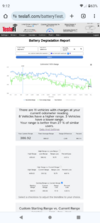From what I have read here, 70, 80 or 90% isn't really much (if any) better than 100% for calendar aging. But if you need the charge for your everyday commute, then there isn't much you can do about it, except charging as late as possible (right before you leave, ideally).I bought my MYP in August 2023, so I used the defaults for months. I think it started at 90% for a bit and then dropped to 80% with my first software update. I started charging at 9pm for a better rate. Eventually I dropped the limit to 75% (could easily go lower) and started the charging later, at 11pm. That to put a bit less stress on it. I drive it 4-5 days a week, typically under 100 miles/day. I have the Tesla wall charger running at 48 amps, and if I want to top up to 90% or more for a long trip I can easily do that over breakfast.
The real benefit seems to come in when you can keep the SOC at or below 55% most of the time.



